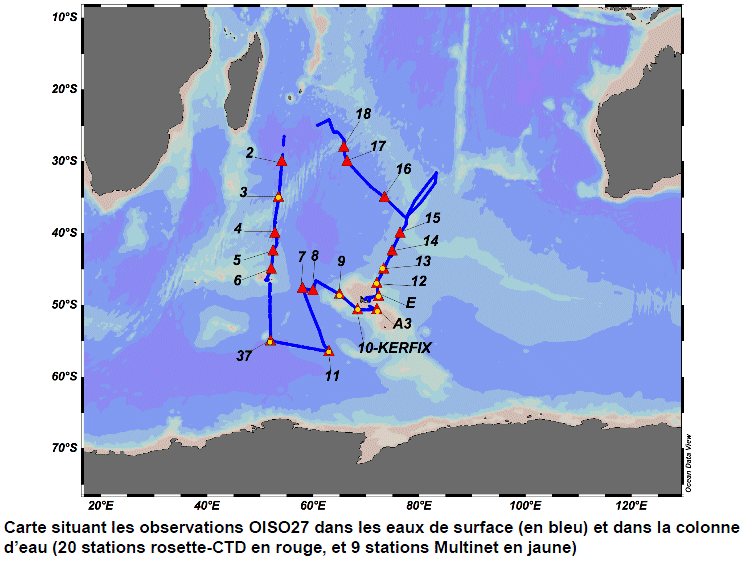VT 153 / OISO-27
| Type | Oceanographic cruise |
|---|---|
| Set | This cruise is part of the set OISO - OCÉAN INDIEN SERVICE D'OBSERVATION |
| Ship | Marion Dufresne |
| Ship owner | TAAF |
| Dates | 04/01/2017 - 10/02/2017 |
| Chief scientist(s) | METZL Nicolas  , LO MONACO Claire , LO MONACO Claire |
LABORATOIRE D'OCÉANOGRAPHIE ET DU CLIMAT : EXPÉRIMENTATIONS ET APPROCHES NUMÉRIQUES - UMR 7159 Institut Pierre Simon Laplace Boîte 100 4 place Jussieu 75005 Paris +33 (1) 44 27 32 48 |
|
| DOI | 10.17600/17009700 |
| Objective | The OISO cruises were initiated in 1998 with the objective of monitoring and understanding the evolution of CO2 in the ocean. Observations are collected once or twice a year onboard R.V. Marion Dufresne in the South Indian and Southern oceans. Such time-series data are crucial in order to: 1) contribute to the annual evaluation of the global carbon budget by regularly feeding international data bases, notably SOCAT and GLODAP; 2) achieve a better understanding of air-sea CO2 flux variability in the South Indian and Southern oceans, with the objective of isolating the anthropogenic perturbation, evaluating the evolution of the oceanic CO2 pump (validation of climate models) and better understanding the mechanisms that drive ocean acidification; 3) document the variability of physical and biological processes that impact the CO2 cycle in the South Indian and Southern oceans; 4) provide in situ observations for the calibration and validation of autonomous observations (e.g., satellite data, Argo, BioArgo and CARIOCA floats, marine mammals equipped with oceanographic sensors); 5) document environmental changes related to climate variability and evaluate the impact on marine organisms (coll., BIAF, MNHN, CEBC). The OISO27 cruise aimed at pursuing observations in surface waters (underway) and in the water column (20 stations) along the route to the French Subantarctic Islands and in the Antarctic ocean. The navigation south of Crozet Island for the REPCOAI program allowed to collect new observations in an unexplored region, that will inform on spatial variability of oceanic CO2 in Antarctic surface waters (underway measurements) and in the water column (stations 11 and 37). In addition, samples were collected for the study of planktonic foraminifera (following previous sampling since 2012 in collaboration with LPG-BIAF) with the objective of progressing on the understanding of the ecology of foraminifera at high latitudes and evaluate the impact of environmental changes (climate change and ocean acidification). The collaboration with a German team (AWI) also allowed to perform measurements of primary production in present and future (warming) conditions. The main goal of this new collaboration aims was to better evaluate the role of diazotrophic organisms in the biological pump of carbon and their response to the expected warming of the ocean. The related projects are LEFE/CO2sink (G. Reverdin), SOERE GREATGASES (P. Ciais), ANR SOBUMS (J. Le Sommer), SOCAT, GLODAP, GOA-ON. |

